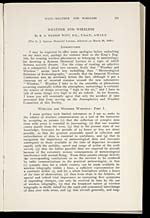Robert Watson-Watt (1892-1973)
Weather and wireless
WATT—WEATHER AND WIRELESS
273
WEATHER AND WIRELESS
By R. A. WATSON WATT, B.Sc, F.Inst.P., A.M.I.E.E.
(The G. J. Symons Memorial Lecture, delivered on March 20, 1929.)
INTRODUCTION
I may be expected to offer some apologies before embarking
on my main text, apology for violence done to the King’s Eng-
lish, for treating wireless phenomena as belonging to meteorology,
for devoting a Symons Memorial Lecture to a topic of which
Symons scarcely dreamt. For the crime of treating an adjective
as a substantive I plead two excuses, firstly that “Weather and
Wireless” seems much less forbidding than “Meteorological
Relations of Radiotelegraphy,” secondly that the Imperial Wireless
Conference was an accessory before the fact, although it put a
timorous set of inverted commas around the new substantive
“Wireless.” Weather I take to be the ensemble of phenomena
occurring essentially within the atmosphere, meteorology is certainly
the science of things occurring “high in the air,” and I have to
talk of some things very high in the air indeed. As for Symons,
I know you will eventually agree that only the accident of time
prevented him from serving on the Atmospherics and Weather
Committee of this Society.
WIRELESS AND WEATHER WARNINGS: PART I.
I must preface such limited references as I am to make to
the subject of wireless communication as a tool of the forecaster,
by accepting as axioms (1) that the collection of synoptic data
from wide areas is essential to forecasting, (2) that our weather
comes mainly from the west, (3) that in the present state of our
knowledge, forecasts for periods of 24 hours or less are alone
possible, so that the greatest attainable speed in collection and
redistribution of data is essential to usefulness, and (4) that in
navigation the importance of meteorological data and forecasts
subsequent to those available at the time of departure increases
rapidly with the mobility, speed and range of action of the craft
served, (5) that the fullest possible data are required by aircraft
because of the extremely serious consequences of meteorological
interference with normal flying. From these axioms emerge directly
the corresponding conclusions as to the services to be rendered
by radio communications to the practical meteorologist, in that
(1) synoptic data for a whole country can be made available by
wireless telegraphy within 1 hour, a sufficient representation for
a continent within 1½, and for a whole hemisphere within 5 hours
of the time of observation, (2) data from ships in the Atlantic, of
special and indeed vital importance as containing first symptoms
of impending changes, can only be received in time by the use
of wireless telegraphy, (3) that the broadcast nature of wireless
telegraphy is ideally suited for the rapid and economical interchange
of data over wide areas, and (4) that aircraft generally, and long-


